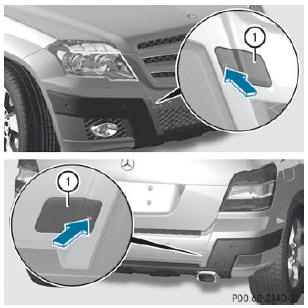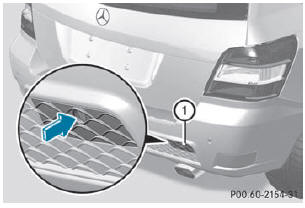Mercedes-Benz GLK-Class: Towing and tow-starting
Important safety notes
![]() WARNING
WARNING
If you tow the vehicle, you must use a rigid towing bar if:
- the engine is not running.
- there is a brake system malfunction.
- there is a malfunction in the power supply or the vehicle's electrical system.
The power assistance for the steering and the brake force booster do not work when the engine is not running. You will need more force to steer and brake, you may have to depress the brake pedal with maximum force.
Before towing away, make sure that the steering can be moved and is not locked. If you tow or tow-start another vehicle, its weight must not exceed the maximum permissible gross vehicle weight of your vehicle.
It is better to have the vehicle transported than to have it towed.
![]() You may only tow the vehicle a maximum distance of 30 miles (50 km). A towing
speed of 30 mph (50 km/h) must not be exceeded.
You may only tow the vehicle a maximum distance of 30 miles (50 km). A towing
speed of 30 mph (50 km/h) must not be exceeded.
For towing distances over 30 miles (50 km), the vehicle must loaded onto a transporter.
![]() Only secure the tow rope or tow bar at the towing eyes. Otherwise, the vehicle
could be damaged.
Only secure the tow rope or tow bar at the towing eyes. Otherwise, the vehicle
could be damaged.
![]() Do not use the towing eye for recovery, as this could damage the vehicle. If
in doubt, recover the vehicle with a crane.
Do not use the towing eye for recovery, as this could damage the vehicle. If
in doubt, recover the vehicle with a crane.
![]() When towing, pull away slowly and smoothly. If the tractive power is too high,
the vehicles could be damaged.
When towing, pull away slowly and smoothly. If the tractive power is too high,
the vehicles could be damaged.
![]() Do not tow with sling-type equipment. This could damage the vehicle.
Do not tow with sling-type equipment. This could damage the vehicle.
![]() On vehicles with KEYLESS-GO, use the SmartKey instead of the Start/Stop button.
Turn the SmartKey to position 2 in the ignition lock and shift the automatic transmission
to N. Then, turn the SmartKey back to 0 and leave it in the ignition lock.
On vehicles with KEYLESS-GO, use the SmartKey instead of the Start/Stop button.
Turn the SmartKey to position 2 in the ignition lock and shift the automatic transmission
to N. Then, turn the SmartKey back to 0 and leave it in the ignition lock.
The automatic transmission must be in position N when the vehicle is being towed.
The battery must be connected and charged. Otherwise, you:
- cannot turn the SmartKey to position 2 in the ignition lock
- cannot shift the automatic transmission to position N
Release the selector lever lock manually to move it out of position P().
![]() Before the vehicle is towed, switch off the automatic locking feature (). You could otherwise be locked out when pushing or towing the vehicle.
Before the vehicle is towed, switch off the automatic locking feature (). You could otherwise be locked out when pushing or towing the vehicle.
Installing/removing the towing eye
Installing the towing eye
Vehicles with a trailer tow hitch: if possible, secure the towing device on the trailer tow hitch ().
X Remove the towing eye from the vehicle tool kit ().
![]() WARNING
WARNING
The exhaust tail pipe may be hot. You could burn yourself if you touch the tail pipe. Be particularly careful when removing the rear cover.
The mountings for the removable towing eyes are located in the bumpers. They are at the front and at the rear, under the covers.

Vehicles without the AMG Sports package

Vehicles with the AMG Sports package
- Press the mark on cover 1 inwards in the direction of the arrow. Rear bumper on vehicles with AMG Sports package: pry cover 1 out of the bumper by inserting a blunt, flat object into the recess.
- Take cover 1 off the opening.
- Screw the towing eye in clockwise to the stop and tighten it.
Removing the towing eye
- Loosen the towing eye and unscrew it.
- Attach cover 1 to the bumper and press until it engages.
- Place the towing eye in the vehicle tool kit.
Towing the vehicle with the rear axle raised
Only possible on vehicles without 4MATIC.
When towing your vehicle with the rear axle raised, it is important that you observe the safety instructions ().
![]() The ignition must be switched off if you are towing the vehicle with the rear
axle raised. Intervention by ESP® could otherwise damage the brake system.
The ignition must be switched off if you are towing the vehicle with the rear
axle raised. Intervention by ESP® could otherwise damage the brake system.
- Switch on the hazard warning lamps ().
- Turn the SmartKey to position 0 in the ignition lock and remove the SmartKey from the ignition lock.
- When leaving the vehicle, take the SmartKey or the KEYLESS-GO key with you.
Towing a vehicle with both axles on the ground
When having your vehicle towed, observe the important safety notes ().
![]() WARNING
WARNING
The power assistance for the steering and the brake force booster do not work when the engine is not running. You will then need much more effort to brake and steer the vehicle. Adapt your style of driving accordingly.
- Switch on the hazard warning lamps ().
![]() When towing with the hazard warning lamps switched on, use the combination
switch as usual to signal a change of direction. In this case, only the turn signals
for the desired direction flash. When the combination switch is reset, the hazard
warning lamps start flashing again.
When towing with the hazard warning lamps switched on, use the combination
switch as usual to signal a change of direction. In this case, only the turn signals
for the desired direction flash. When the combination switch is reset, the hazard
warning lamps start flashing again.
- Turn the SmartKey to position 2 in the ignition lock.
- When the vehicle is stationary, depress the brake pedal and keep it depressed.
- Shift the automatic transmission to position N.
- Release the brake pedal.
- Release the parking brake.
Transporting the vehicle
The towing eyes or trailer tow hitch can be used to pull the vehicle onto a trailer or transporter if you wish to transport it.
- Turn the SmartKey to position 2 in the ignition lock.
- Shift the automatic transmission to position N.
As soon as the vehicle is loaded:
- Prevent the vehicle from rolling away by applying the parking brake.
- Move the selector lever to P.
- Turn the SmartKey to position 0 in the ignition lock and remove the SmartKey from the ignition lock.
- Secure the vehicle.
![]() Only lash the vehicle down by the wheels or wheel rims, not by parts of the
vehicle such as axle or steering components. Otherwise, the vehicle could be damaged.
Only lash the vehicle down by the wheels or wheel rims, not by parts of the
vehicle such as axle or steering components. Otherwise, the vehicle could be damaged.
Notes for 4MATIC vehicles
![]() Vehicles with 4MATIC must not be towed with either the front or the rear axle
raised, as doing so will damage the transmission.
Vehicles with 4MATIC must not be towed with either the front or the rear axle
raised, as doing so will damage the transmission.
If the vehicle has transmission damage or damage to the front or rear axle, have it transported on a transporter or trailer.
In the event of damage to the electrical system
If the battery is defective, the automatic transmission will be locked in position P. To shift the automatic transmission to position N, you must provide power to the vehicle's electrical system in the same way as when jump-starting ().
Have the vehicle transported on a transporter or trailer.
Recovering a vehicle that has become stuck
![]() Pull away smoothly, slowly, and in a straight line when pulling
out a vehicle that has become stuck. Excessive tractive power could damage the vehicles.
Pull away smoothly, slowly, and in a straight line when pulling
out a vehicle that has become stuck. Excessive tractive power could damage the vehicles.
If the drive wheels have become stuck in loose or muddy ground, pull the vehicle out with extreme caution, particularly if it is laden.
Never attempt to recover a stuck vehicle with a trailer attached.
Pull out the vehicle backwards, if possible using the tracks it made when it became stuck.
Tow-starting (emergency starting)
![]() Vehicles with automatic transmission must not be started by
tow-starting. This could otherwise damage the transmission.
Vehicles with automatic transmission must not be started by
tow-starting. This could otherwise damage the transmission.
See also:
If the engine will not start
WARNING:
If the engine will not start, do not push or
pull the car to start it. This could result in a
collision or cause other damage. In addition,
push or pull starting may cause the
catalytic converter to be overloaded and
create a fir ...
Roof Rack System
WARNING
If something is carried on top of the vehicle that is longer or wider than the
roof rack—like paneling, plywood, or a mattress—the wind can catch it while the
vehicle is being driven. The item being carried could be violently torn of ...

 Jump-starting
Jump-starting